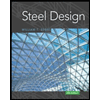
Concept explainers
(a)
The design of a single-angle tension member using Load Resistance Factor Design (LRFD).
Answer to Problem 3.6.1P
The single angle tension member using LRFD is
Explanation of Solution
Given:
The member is
Dead Load is
Live load is
Concept Used:
Write the expression for factored load.
Here, the factored load is
Write the expression for the required gross area.
Here, the gross area is
Write the expression for the required effective area.
Here, the required effective area is
Write the expression for the effective area of the section.
Here, the effective area of the section is
Write the expression for the net area of the section.
Here, the gross area of the section is
Calculation:
Calculate the factored load.
Substitute
Calculate the required gross area of the tension member.
Substitute
Calculate the required net area of the tension member.
Substitute
Before choosing the sections calculate the minimum radius of gyration.
Write the expression for the radius of gyration.
Here, the minimum radius of gyration is
Substitute
Choose the section that has parameters slightly above the required values.
Trial 1:
Choose the section
The properties of the section are,
Here, the gross area of the section is
Compare the gross area.
Hence, the section is feasible.
Compare the radii of gyration.
Hence, the section is feasible.
Calculate the net area of the section.
Substitute
Calculate the effective area of the section.
Substitute
Compare the effective area required and that of the section.
Hence, the section is feasible for design.
Adopt the section
Conclusion:
Thus, the single angle tension member using LRFD is
(b)
The single angle tension member using Allowable Strength Design (ASD).
Answer to Problem 3.6.1P
The single angle tension member using ASD is
Explanation of Solution
Concept used:
Write the expression for factored load,
Here, the factored load is
Write the expression for the required gross area.
Write the expression for the required effective area.
Write the expression for the effective area of the section.
Here, the effective area of the section is
Calculation:
Calculate the factored load.
Substitute
Calculate the required gross area of the tension member.
Substitute
Calculate the required net area of the tension member.
Substitute
Before choosing the sections calculate the minimum radius of gyration.
Substitute
Choose the section that has parameters slightly above the required values.
Trial 1:
Choose the section
The properties of the section are,
Here, the gross area of the section is
Compare the gross area.
Hence, the section is feasible.
Compare the radii of gyration.
Hence, the section is feasible.
Calculate the net area of the section.
Substitute
Calculate the effective area of the section.
Substitute
Compare the effective area required and that of the section.
Hence, the section is feasible for design.
Adopt the section
Conclusion:
Thus, the single angle tension member using ASD is
Want to see more full solutions like this?
Chapter 3 Solutions
Steel Design (Activate Learning with these NEW titles from Engineering!)
- *8-60. The 2-in.-diameter rod is subjected to the forces shown. Determine the state of stress at point B, and show the results on a differential element located at this point. Probs. 8-59/60 B 8 in. 600 lb 12 in. 500 lb 800 lbarrow_forwardfind SFD and BMD by using slope deflection methodarrow_forwardThe following relates to Problems 4 and 5. Christchurch, New Zealand experienced a major earthquake on February 22, 2011. It destroyed 100,000 homes. Data were collected on a sample of 300 damaged homes. These data are saved in the file called CIEG315 Homework 4 data.xlsx, which is available on Canvas under Files. A subset of the data is shown in the accompanying table. Two of the variables are qualitative in nature: Wall construction and roof construction. Two of the variables are quantitative: (1) Peak ground acceleration (PGA), a measure of the intensity of ground shaking that the home experienced in the earthquake (in units of acceleration of gravity, g); (2) Damage, which indicates the amount of damage experienced in the earthquake in New Zealand dollars; and (3) Building value, the pre-earthquake value of the home in New Zealand dollars. PGA (g) Damage (NZ$) Building Value (NZ$) Wall Construction Roof Construction Property ID 1 0.645 2 0.101 141,416 2,826 253,000 B 305,000 B T 3…arrow_forward
- find SFD and BMDarrow_forwardThe data needed to answer this question is given by this link: https://docs.google.com/spreadsheets/d/1vzb03U7Uvzm7X-by3OchQNwYeREzbP6Z-xzZMP2tzNw/edit?usp=sharing if it is easier to make a copy of the data because it is on view only then feel free to do so.arrow_forwardThe data needed to answer this question is given in the following link (file is on view only so if you would like to make a copy to make it easier for yourself feel free to do so) https://docs.google.com/spreadsheets/d/1aV5rsxdNjHnkeTkm5VqHzBXZgW-Ptbs3vqwk0SYiQPo/edit?usp=sharingarrow_forward
- The benchmark is 00.00. The backsights are 6.00, 9.32 and 13.75 and 14.00 The foresights are 6.00, 9.00 and 3.22. What is the height of the instrument? H.I. - 100.00 - 124.85 - 43.07- 24.85arrow_forwardThe benchmark is 100.00. The backsights are 4.00, 6.32 and 12.75. The foresights are 6.00, 9.00 and 3.22. What is the elevation of the point? - 95.14 - 123.08 - 104.85 - 81.78arrow_forwardDetermine the stiffness matirx of the entire truss in Global co-ordinate system, clearly indicate the degrees of freedom numbers in the stiffness matrix.arrow_forward
 Steel Design (Activate Learning with these NEW ti...Civil EngineeringISBN:9781337094740Author:Segui, William T.Publisher:Cengage Learning
Steel Design (Activate Learning with these NEW ti...Civil EngineeringISBN:9781337094740Author:Segui, William T.Publisher:Cengage Learning
